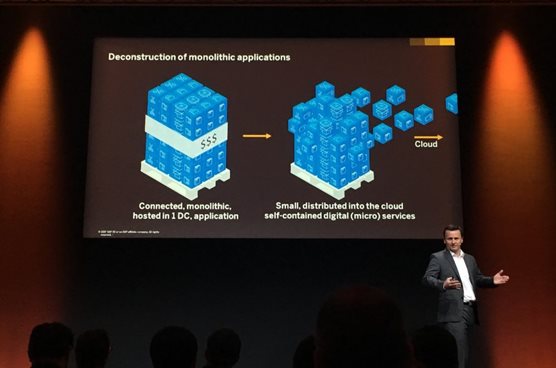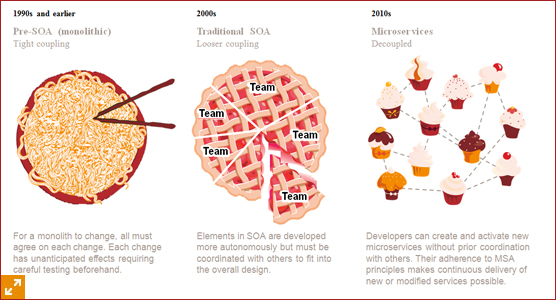Explained: SAP Hybris Revenue Cloud & Microservices
SAP is committed to change the way you sell your products, deliver services, integrate billing, and interact with your end customers. Therefore, during its SAP Hybris LIVE: Digital Summit event, they announced the extension of their customer engagement and commerce cloud suite with the availability of the SAP Hybris Revenue Cloud solution which integrates order configuration, pricing, quoting, order orchestration and subscription billing, all in the cloud.
“Client business models are changing, and digital is at the forefront of every customer  interaction across all channels,” said Brian Walker, chief strategy officer, SAP Hybris. “With the addition of SAP Hybris Revenue Cloud to our portfolio of cloud solutions, we are ideally positioned to help clients take advantage of disruption occurring in their markets, develop new business models and focus on what really matters — delivering outstanding customer experiences.”
interaction across all channels,” said Brian Walker, chief strategy officer, SAP Hybris. “With the addition of SAP Hybris Revenue Cloud to our portfolio of cloud solutions, we are ideally positioned to help clients take advantage of disruption occurring in their markets, develop new business models and focus on what really matters — delivering outstanding customer experiences.”
SAP Hybris Revenue Cloud is designed based on a microservices architecture that enables partners and customers to build and harness flexible extensions and solutions. The SAP Hybris cloud suite can run on SAP Hybris as a Service, (also known as YaaS) that, according to SAP, helps businesses rapidly and easily augment and enhance their existing solutions with microservices and software-as-a-service applications. The newly announced solution is a simplified, automated approach to managing orders and billing processes, collecting valuable product and customer data, testing new offers, and keeping track of usage information.
During the event, Carsten Thoma, President and Co-Founder of SAP Hybris, stressed how organizations can deliver a holistic digital experience simply by adopting an omnichannel strategy for providing their products or services and utilizing microservices as the foundation.

What is Microservices & Why Should You Care?
Before diving into the technical definition, I would like to inquire which of the following align with your organizations objectives:
-
Entering into new markets
-
Respond quickly to new market conditions
-
Orchestrating business capabilities and systems
-
Rapid decision making
-
Innovating
-
Compete with market disruptors
Keeping up with today’s ever-changing customer interaction trends require the flexibility to launch cutting-edge apps that engage your customers on any device without sacrificing security and without breaking your budget. To thrive on this type of flexibility, you will eventually need to decompose a monolith application into smaller, manageable services which are called microservices.
The idea behind microservices is to build apps as suites of independently deployable services so each capability (report generation, document management, customer relations) can be treated as a separate process. As a result, companies can quickly change, test and improve offerings based on real-time insights gained from integrated customer information systems.
Replatforming to a Microservices Architecture
Enterprise Applications are often made up of three main parts: a client-side user interface, a database, and a server-side application. Any changes to the system require building and deploying a new version of the server-side application. With the monolithic server, frustration can be inevitable as a change made to a small part of the application involves the entire monolith to be rebuilt and deployed. In the end, it becomes tough to keep a good modular structure, making it harder to keep changes that are only related to one module within that module. If you want to scale it, then again, it requires scaling of the entire application rather than parts of it that require greater resource.
In other words, while a monolithic application puts all its functionality into a single process, a microservices architecture puts each element of functionality into a separate service, and those services can be managed by independent teams. In this way, this shift doesn’t only allow organizations to be more nimble but also more productive and faster to market.

Advantages of the Microservices Applications
-
With the microservices architecture, you do not need teams to rewrite the whole application if they want to add new features.
-
Since microservices often use different tech stacks, smaller codebases make maintenance easier and faster. Additionally, microservices can be upgraded with no impact to the system which increases overall productivity by saving development effort and time.
-
The parts of an application can be scaled separately and are easier to deploy.
-
Instead of developing applications from the ground up, existing services can be adapted to build custom experiences on the fly.
-
Dependency concerns will be far lighter than with monolithic designs, and rolling back changes much easier.
-
In the case of the failure of a single module, the error can be isolated from the rest of the application.
-
Applications that use microservices architecture can seamlessly run on multiple devices such as desktops, smart phones, internet-of-things etc.
It also has some disadvantages but they can be overcome with the right automations and tools.
How Enterprises Benefit from Microservices Architecture?
The IT Department of Walmart Canada, for instance, was faced with a huge issue that their website couldn’t handle 6 million pageviews per minute and made it impossible to keep any kind of positive user experience anymore on Black Fridays for two years in a row. In 2012, the organization shifted from the monolithic system to the microservices system. As a result, conversions were up by 20% overnight, mobile orders were up by 98% immediately, and there was zero downtime during peak events such as Black Friday or Boxing Day since the replatforming. “Building microservice architectures are really the key to staying in front of the demands of the market. It’s not just a sort of replatforming for the sake of technology. It’s about the overall market in general, about what users expect and what businesses expect to stay competitive,” said Kevin Webber, CEO at RedElastic.
Neftlix is also one of the first companies to adopt the microservices technology in 2012 after the incident almost resulted in bringing the whole system down. Previously, they had a software development team including over 100 developers. With the shift, the organization tapped into one of the greatest advantages of taking apart a monolith into multiple manageable services, enabling a small team to fully manage the lifecycle of its service - develop, test, and push to production. Netflix formed multiple small teams that support hundreds of processes running within the application. Since every microservice has a separate data storage solution, the company was no longer having to update services one by one in the case that they make a change to its database. As a result, Netflix’ platform became faster in responding to audience needs and able to experiment with innovative initiatives.
Besides these, Amazon, Ebay, PayPal, Gilt, Guardian, Microsoft and many other large-scale websites and applications have evolved from monolithic to microservices to gain a competitive advantage over their rivals.
My POV
It is clear that microservices are changing enterprise application architectures as we witness that most SaaS vendors are already using microservices in their production services. At the event, SAP's Carsten Thoma also said that microservices might be even more disruptive than any other tech paradigm shift that has come before, and he is not the only industry insider that has such bold predictions on this emerging trend. Therefore, considering SAP has 345,000 corporate customers, 110,000 cloud users and 15,000 business partners, adding another cloud-based microservices to SAP Hybris as a Service means that the the market is shifting to replatforming to a microservices architecture, and the new offering will definitely help SAP leapfrog the cut-throat competition where Salesforce and Microsoft have had an established portfolio and growing customer base.

Venus Tamturk
Venus is the Media Reporter for CMS-Connected, with one of her tasks to write thorough articles by creating the most up-to-date and engaging content using B2B digital marketing. She enjoys increasing brand equity and conversion through the strategic use of social media channels and integrated media marketing plans.